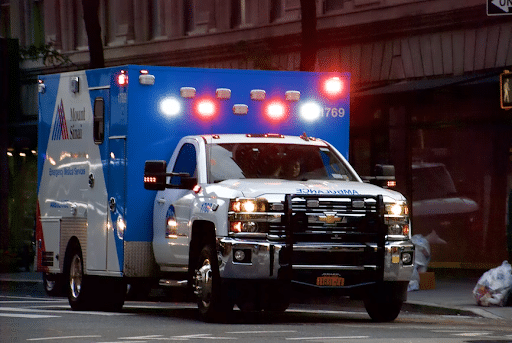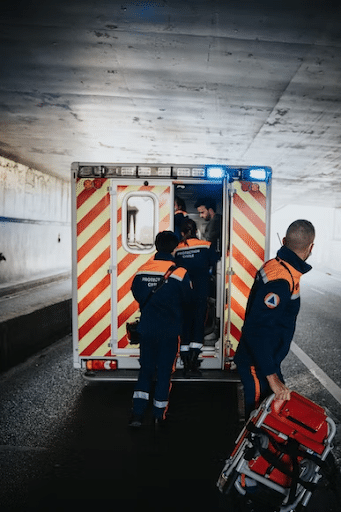Welcome to your basic explanation of the Trauma Triad Of Death.

This is a medical term which can easily be complicated by scientific explanations. Below, I’ll do my best to simplify it as much as possible.
This could help to improve your understanding of what trauma victims go through.
So, let’s dive in.
Trauma Triad Of Death Explained
The trauma triad of death is a series of three medical conditions which combine to cause the death of a trauma patient. These three conditions in the lethal triad are inter-related, meaning one problem can cause the other two.
For reference, a trauma injury is a sudden and serious injury to the body that requires immediate medical injury. Trauma injuries most commonly occur from a powerful strike to the body or the body being deeply penetrated.
What Are The 3 Elements Of The Trauma Triad Of Death?
The three elements of the death triad are coagulopathy, acidosis and hypothermia.
Trauma Triad Of Death Components
- Coagulopathy. This is when the blood’s ability to form clots is impaired. It can cause prolonged or excessive bleeding. This can occur following an injury or a surgery. It might also happen because of dilution, consumption, low temperature or acidosis among other reasons.
- Metabolic Acidosis. An increase in lactic acid and an inability to clear it. This can be caused by a lack of perfusion in your end organs. If one has kidney problems, that’s a common reason why the body may be unable to clear their lactic acid effeciently.
- Hypothermia. This is an extremely low body temperature. This can be caused by spending too long in the cold, but also a lack of perfusion or cardiac output in the body.
What Causes The Trauma Triad Of Death?
It’s called the death triad because one condition can compound the other two. Trauma patients are therefore often found to have all three conditions, significantly escalating their mortality risk.
There are a number of ways that one death triad condition can lead to the others.
For example:
- If you’re suffering from mild or severe hypothermia, you’ll become coaglopathic because the proteins in your coagulation system won’t be able to function as they should.
- With mild hypothermia, you’ll also suffer from metabolic acidosis because your body is unable to clear acids as well at a low body temperature.
- It also can’t clear your acids as well as at a decreased cardiac output, and there we find a link between metabolic acidosis and coagulopathy.
- Severe bleeding caused by coagulopathy can diminish oxygen delivery, lowering body temperature and causing hypothermia.
The list goes on…
Trauma Triad Of Death Treatment
In cases of major trauma, medical teams are taught to identify high-risk patients and understand where immediate damage control surgery is needed. The medical team will rapidly assess the injuries and do what they can to stablise the patient.

The initial steps will usually involve limiting the bleeding with direct pressure, as well as raising the patient’s body temperature as they transport them to the emergency department of the trauma center.
Trauma care in the prehospital setting will often include high-flow oxygen, regardless of the patient’s oxygen saturation, if the patient has been critically injured.
In the trauma center, it’s common that large teams are required to work on trauma patients in the operating room. This could include an emergency physician, anaesthetists, orthopaedic surgeons or neurosurgeons depending on the injuries.
It’s common that ongoing trauma care is necessary in the intensive care unit, especially in cases of injuries to vital organs.
Once the patient is stablised, they’ll remain in the adult major trauma centre and will be referred to a specialist doctor as necessary.
Frequently Asked Questions
Who Invented Trauma Triad Of Death?
In 1982, a study published by the American Trauma Society outlined the “bloody vicious cycle,” acidosis, hypothermia, and coagulopathy. The paper highlighted how one factor compounds the others, leading to a greater risk of death in trauma patients.
The goal of the study was to explore ways to manage major trauma patients presenting the triad of death.
Work is still being done to improve patient outcomes, as a poor outcome remains likely in severe cases.
What Is The Triangle Of Death In Medical Terms?
Here are some important medical terms to be aware of in relation to the death triad.
- Acute traumatic coagulopathy. A quick and severe damage to the blood clotting process that occurs quickly after a traumatic injury
- Respiratory acidosis. This occurs when your lungs can’t remove all of the carbon dioxide produced by your body. This causes the blood and other body fluids to become too acidic. Despite the significant differences, this can incite death triad symptoms just as well as metabolic acidosis.
- Congestive heart failure. It can occur as a result of penetrating trauma in the chest, or extreme alcohol intoxication, although it’s more commonly caused lifestyle choices that lead to heart problems.
- Coagulation system. This is part of the circulation system responsible for creating blood clots preventing both internal and external hemorrhage.
- Trauma resuscitation. The process of reviving a trauma patient, who has lost consciousness due to shock or damage to vital organs.
- Peripheral Vasoconstriction. This is the process of blood vessels constricting when someone has a low body temperature. This process improves the body’s ability to stay warm, but extreme cases can lead to hypertension or high systolic blood pressure.
- Accidental hypothermia. When a patient accidentally allows the core body temperature to drop below 35C. A trauma patient’s temperature would drop as a result of other problems, so this wouldn’t qualify as accidental.
- Crystalloid fluids. These are intravenous solutions frequently used for fluid resuscitation of a trauma patient. Clinicians are advised to limit crystalloid infusion in trauma patients as this can increase their acidosis, especially in cases of low systolic blood pressure.
- Anaerobic metabolism. The process of the body burning glucose when it’s deprived of oxygen. This is crucial during a severe loss of blood and therefore oxygen. However, a side-effect of this process is more lactic acid entering the blood stream, causing acidosis.
What Are The Methods We Can Prevent The Triad Of Death In Trauma?
Trauma injuries are often sudden and serious. The onset of the death triad symptoms are rapid and difficult to prevent. As such, medical teams often have to work to cure the death triad, rather than prevent it.
How Dangerous Is The Lethal Triad For A Trauma Patient?
The symptoms of the death triad, or lethal triad as it’s sometimes called, carry a severe risk of a death emergency. The effects of this lethal triad are the major contributor towards death in trauma patients. Indeed, trauma is the leading cause of death in Americans aged 1-44.
Related Content: Existential Questions With Life-Changing Potential
Any More Questions?
Thanks for reading my guide.
If you have any questions on this topic, feel free to leave me a comment below.
It would be great to hear from you.
